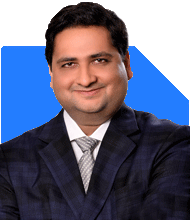Ramalingam Kalirajan |10870 Answers |Ask -Follow
Mutual Funds, Financial Planning Expert - Answered on May 05, 2024
He has an MBA in finance from the University of Madras and is a certified financial planner.
He is the director and chief financial planner at Holistic Investment, a Chennai-based firm that offers financial planning and wealth management advice.... more

Sir, I started investing in MFs since 2007. These are the schemes where I am investing currently. Do I need to make any changes to my portfolio? I am planning to invest Rs 50,000 per month for a period of 20 years. I want a corpus of Rs 5 cr after 20 years. Do I need to add any new schemes to reach my target? * Mirae Asset Tax Saver Fund G * Motilal Oswal NASDAQ 100 ETF * Parag Parikh Flexi Cap Fund * Aditya Birla Sun Life Mfg Equity Fund * Aditya Birla Sun Life Tax Relief 96 * 360 One Focused Equity Fund - Growth * Mirae Asset Emerging Bluechip Fund - Growth * Quant Tax Plan * Axis Bluechip fund * Canara Robeco Emerging Equities * Canara Robeco Equity Tax Saver * HDFC Gold Trader Fund Growth - Direct * HDFC Tax saver ICICI Prudential Technology Fund – Growth
To reach your target corpus of Rs 5 crore in 20 years with a monthly investment of Rs 50,000, it's essential to periodically review and adjust your portfolio. Consider rebalancing to ensure alignment with your goals and market conditions.
While your current portfolio includes a mix of equity, tax-saving, and thematic funds, consider adding diversified options to enhance portfolio resilience. Focus on funds with strong track records, experienced fund managers, and consistent performance.
As market dynamics evolve, keep an eye on new investment opportunities and emerging sectors. Stay informed and open to adjustments to optimize your portfolio for long-term growth and stability.
Remember, investing is a journey, and it's essential to stay patient, disciplined, and focused on your goals. With prudent planning and regular review, you're well-positioned to achieve your financial aspirations. Keep up the good work!
You may like to see similar questions and answers below
Hardik Parikh | Answer |Ask -Follow
Tax, Mutual Fund Expert - Answered on Apr 19, 2023
Hardik Parikh | Answer |Ask -Follow
Tax, Mutual Fund Expert - Answered on Apr 20, 2023
Ramalingam Kalirajan |10870 Answers |Ask -Follow
Mutual Funds, Financial Planning Expert - Answered on May 26, 2024
Ramalingam Kalirajan |10870 Answers |Ask -Follow
Mutual Funds, Financial Planning Expert - Answered on Apr 12, 2024
Dr Dipankar Dutta |1837 Answers |Ask -Follow
Tech Careers and Skill Development Expert - Answered on Dec 05, 2025
Dr Shyam Jamalabad |108 Answers |Ask -Follow
Dentist - Answered on Dec 05, 2025
Dr Shyam Jamalabad |108 Answers |Ask -Follow
Dentist - Answered on Dec 05, 2025
Dr Shyam Jamalabad |108 Answers |Ask -Follow
Dentist - Answered on Dec 05, 2025
Dr Dipankar Dutta |1837 Answers |Ask -Follow
Tech Careers and Skill Development Expert - Answered on Dec 05, 2025
Ulhas Joshi |280 Answers |Ask -Follow
Mutual Fund Expert - Answered on Dec 05, 2025
Dr Dipankar Dutta |1837 Answers |Ask -Follow
Tech Careers and Skill Development Expert - Answered on Dec 04, 2025
Ravi Mittal |676 Answers |Ask -Follow
Dating, Relationships Expert - Answered on Dec 04, 2025
Anu Krishna |1745 Answers |Ask -Follow
Relationships Expert, Mind Coach - Answered on Dec 04, 2025
Anu Krishna |1745 Answers |Ask -Follow
Relationships Expert, Mind Coach - Answered on Dec 04, 2025



























